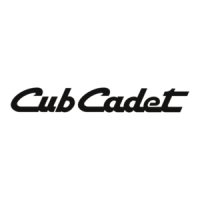17Section 3 — controlS & operation
3. To turn counter-clockwise, move the right
control lever forward while simultaneously
moving the left control lever rearward. See
Figure 3-12.
Counter-clockwise
Zero Turn
Figure 3-12
Executing a “Y” Maneuver
For low traction conditions, follow these
procedures for zero turns (the “Y-maneuver”):
To turn clockwise (front of machine moves toward
RIGHT) when traveling FORWARD:
1. Come to a stop.
2. Slowly move both lap bars rearward (no
more than 1/2 maximum reverse speed) to
initiate REVERSE travel.
3. Slowly move the LEFT lap bar forward
while maintaining the RIGHT lap bar in the
rearward travel position.
4. To stop the turn and re-initiate FORWARD
travel, slowly move the RIGHT lap bar from
the REVERSE travel position to a FORWARD
travel position equal to that of the LEFT
lap bar.
5. For counter-clockwise turns, reverse the
above procedure.
Stopping the Tractor
1. Move both drive control levers to the
neutral position to stop the motion of
the tractor.
2. Push the PTO switch downward to the
disengaged position.
3. Use the deck lift pedal to raise the deck to
its highest position and secure in place with
the clevis pin attached to the tractor.
4. If dismounting the tractor, move the drive
control handles fully outward in the neutral
position, engage the parking brake, move
the throttle control lever (if equipped) to the
FAST position, turn the ignition switch
to STOP and remove the ignition key from
the switch.
WARNING
Do not leave the seat of the tractor without disengaging the
PTO, moving drive control levers fully outward in the neutral
position engaging the parking brake. If leaving the tractor
unattended, turn the ignition key OFF and remove.
Driving On Slopes
Refer to the slope gauge in the Safe Operation
Section to help determine slopes where you may
operate safely.
WARNING
Do not operate on inclines with a slope in excess of 15°/25%
(a rise of approximately 4 feet every 10 feet). The machine
could overturn and cause serious injury.
1. Always drive across slopes, never up and
down. Control the speed and direction of
the tractor using primarily the control lever
on the downhill side of the tractor, with the
uphill control lever remaining essentially in
a fixed position.
2. Avoid turning downhill if possible. Start at
the bottom of a slope and work upward.
Always slow down before turning.
3. Use extra care and go slowly when
turning downhill.
Operating the PTO
Operate the PTO as follows:
1. Move the throttle to approximately the mid-
throttle position.
2. Pull the PTO upward to the “ENGAGED”
position.
3. Advance the throttle to the operating speed
(full engine speed).
The operator must remain in the tractor seat at all
times. If the operator should leave the seat without
turning off the power take-off switch, the tractor’s
engine will shut off.
Using the Mower Deck
WARNING
Make certain the area to be mowed is free of debris, sticks,
stones, wire, or other objects that can be thrown by the
rotating blades.
Note: Do not engage the mower deck when
lowered in grass. Premature wear and possible
failure of the “V” belt and PTO clutch will result.
Fully raise the deck or move to a non-grassy area
before engaging the mower deck.
1. Use the deck lift pedal (a) to raise the deck
to its highest position, place the clevis pin
(b) attached to the tractor into the desired
index hole on the deck height index, then
slowly release the deck lift pedal (a). See
Figure 3-13.
Figure 3-13
2. Mow across slopes, not up and down. If
mowing a slope, start at bottom and work
upward to ensure turns are made uphill.
3. On the first pass pick a point on the
opposite side of the area to be mowed.
4. Engage the PTO knob and move the throttle
control to the operating speed (full throttle)
position.
5. Remove the clevis pin, raise the deck to the
highest (transport) position, place the clevis
pin in the desired position and secure with
the clevis pin. Lower the mower deck to the
desired height setting.
6. Slowly push the drive control levers forward
to move the tractor forward, and keep
the tractor headed directly toward the
alignment point.
Note: The speed of the tractor will affect
the quality of the mower cut. Mowing at full
speed will adversely affect the cut quality.
Control the ground speed with the drive
control levers.
7. When approaching the other end of the
strip, slow down or stop before turning. A
U-turn is recommended unless a pivot or
zero turn is required.
8. Align the mower with an edge of the
mowed strip and overlap approximately 3”.
9. Direct the tractor on each subsequent strip
to align with a previously cut strip.
10. To prevent rutting or grooving of the turf, if
possible, change the direction that the strips
are mowed by approximately 45° for the next
and each subsequent mowing.
WARNING
Be careful when crossing gravel paths or driveways.
Disengage the PTO knob and raise the deck to the highest/
transport position before crossing.
Note: When stopping the tractor for any
reason while on a grass surface, always:
• Make sure the drive control levers
are in neutral.
• Engage the parking brake.
• Shut engine off and remove the key.
• Doing so will minimize the
possibility of having your lawn
‘‘browned’’ by hot exhaust from your
tractor’s running engine.

